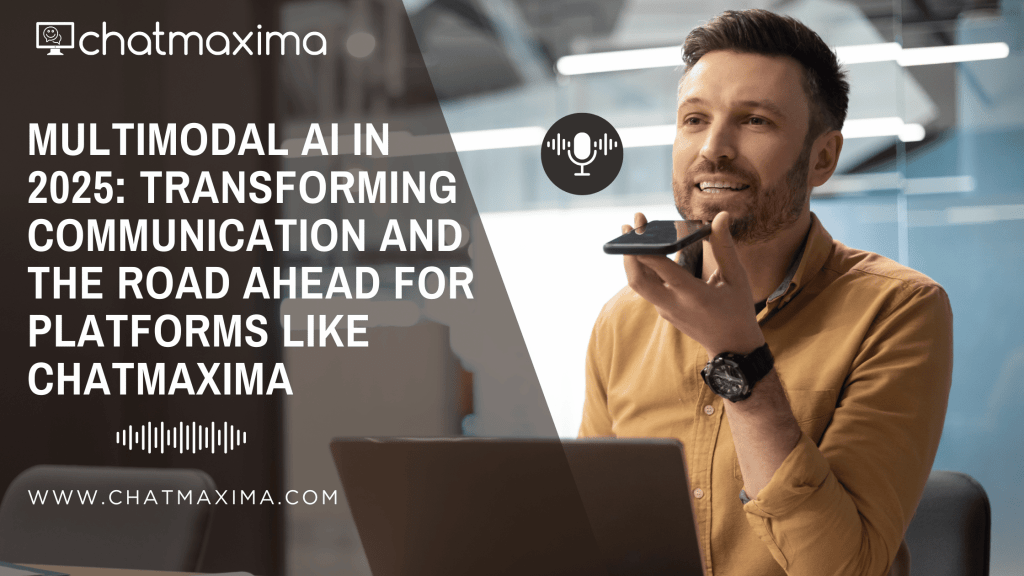In 2025, multimodal AI has emerged as a transformative force at the intersection of artificial intelligence and communication. Unlike traditional models limited to text or single formats, multimodal AI systems are now capable of understanding and generating content across a range of data types—text, images, audio, and video—mirroring the way humans naturally communicate.
At ChatMaxima, we’re closely tracking this evolution. As a conversational marketing platform, we understand how vital it is to provide contextual, seamless, and dynamic experiences for customers. This deep-dive explores what multimodal AI means in today’s world, how it is shaping industries, and what role platforms like ChatMaxima can play in this rapidly changing landscape.
What Is Multimodal AI?
Multimodal AI refers to systems that can process and respond to multiple types of inputs. For example, a single AI agent might interpret a customer’s voice query, review an image of a product, and generate a helpful video or text response—all in real-time.
In essence, these systems are built to understand the richness of human communication, integrating verbal cues, visual context, tone, and more. Powered by foundation models such as OpenAI’s GPT-4, Google’s Gemini, and others, these AI tools are increasingly being integrated into consumer apps, enterprise software, and digital assistants.
2025: Key Developments in Multimodal AI
As of mid-2025, the field of multimodal AI has matured rapidly. Here are some of the major trends shaping its evolution:
🔹 1. Foundation Models Go Multimodal
Models like Gemini, GPT-4, and Claude are designed from the ground up to handle cross-format reasoning. Tasks such as image captioning, visual document analysis, and speech-to-image generation are now possible in production-grade systems. According to a February 2025 Forbes article, these models are setting new benchmarks for content comprehension and generation.
🔹 2. Rise of Autonomous AI Agents
AI agents are now capable of autonomously analyzing multimodal inputs to execute complex workflows. A December 2024 Microsoft research paper details how enterprises are automating HR reporting, content creation, and knowledge management using these agents—freeing up human teams to focus on strategic work.
🔹 3. Open-Source Acceleration
Open-source AI ecosystems—led by platforms like Hugging Face, Twelve Labs, and Google AI—are democratizing access. As highlighted by IBM and SuperAnnotate, companies are building multimodal solutions 50% faster by leveraging open tooling, community datasets, and shared model checkpoints.
🔹 4. Industry-Level Adoption
Multimodal AI is already driving innovation in several key industries:
- Healthcare: Summarizing patient histories with data from EHRs, smartwatch sensors, and CT scans.
- eCommerce: Matching product images to customer reviews and generating personalized product suggestions.
- Education: Creating immersive, multimodal lessons combining video, text, and simulations for higher engagement.
Challenges and Ethical Considerations
The rise of multimodal AI comes with its share of challenges:
- Biases in Training Data: When datasets lack diversity across modalities, AI outputs can become skewed.
- Privacy Risks: Images, audio, and videos carry more sensitive information than text, requiring stricter data governance.
- Model Complexity: Training and fine-tuning these systems demand significant computational and financial resources.
These issues were explored extensively in MIT Technology Review’s 2025 outlook, which calls for more transparent model evaluation frameworks and tighter regulation around sensitive data.
ChatMaxima in the Multimodal Era
While ChatMaxima today operates primarily in a text-first ecosystem, our architecture is future-ready for multimodal AI. Let’s take a closer look at what we offer—and where we’re headed.
✅ AI-Powered Chatbots & Agents
Our platform supports no-code chatbot creation using drag-and-drop interfaces. With a 92% automation rate and 85% customer satisfaction (as reported in 2025 by Capterra users), these bots handle inquiries 24/7.
What’s next?
Multimodal capabilities could allow our bots to analyze image uploads, voice notes, or even product videos—adding richer context to conversations.
✅ Omnichannel Communication
ChatMaxima integrates with WhatsApp, Instagram, Telegram, Facebook Messenger, SMS, and web chat. This unified inbox ensures brands never miss a message—regardless of where it comes from.
What’s next?
Multimodal AI can unify data across channels, allowing businesses to reply to an image shared on WhatsApp or a voice note from Instagram with intelligent context.
✅ Drag-and-Drop Bot Studio
Our no-code bot builder empowers even non-tech teams to launch complex conversation flows within minutes.
What’s next?
Imagine using the same builder to insert a short video response, dynamic infographic, or image gallery based on AI analysis of the user’s input.
✅ AI-Powered Insights
Our reporting dashboard gives businesses real-time performance analytics, helping them fine-tune their campaigns and conversations.
What’s next?
Future analytics may include sentiment analysis from voice tone, click-through rates on image carousels, and engagement heatmaps from interactive content.
Comparative Table: ChatMaxima Features vs. Multimodal Potential
| Feature | Current Status | Future with Multimodal AI |
|---|---|---|
| AI Chatbots & Agents | 92% automation using text | Add voice, image, and video-based understanding |
| Omnichannel Support | Centralized inbox for text channels | Intelligent responses to images/audio across all channels |
| No-Code Bot Builder | Drag-and-drop text response flows | Support for inserting AI generated multimedia content in flows on the fly |
| AI Insights & Analytics | Text-based metrics | Multimodal data analysis: voice tone, visual cues, cross-modal trends |
| Support for AI Models | GPT-4, Gemini, Claude, Deepseek, Llama | Gemini & Claude multimodal extensions ready for deeper integration |
The Road Ahead: Opportunities in Multimodal AI
As businesses begin to prioritize rich communication, the demand for multimodal capabilities will continue to rise. Here’s what we expect in the coming year:
- Smarter AI Agents: Capable of contextualizing queries by combining text, images, and voice inputs.
- Hyper-Personalization: Use of browsing behavior, uploaded photos, and spoken preferences for next-level product recommendations.
- Cross-Industry Disruption: From AR-based shopping experiences to AI-powered video tutoring, multimodal systems will redefine digital experiences.
- Ethics-First Development: Developers must proactively address fairness, transparency, and privacy concerns while training on multimodal datasets.
Final Thoughts: ChatMaxima’s Role in a Multimodal Future
Multimodal AI isn’t just a trend—it’s a paradigm shift. As the lines between written, visual, and spoken communication blur, platforms like ChatMaxima are well-positioned to evolve and lead the charge in customer engagement innovation.
Our current focus on accessible AI tooling, unified messaging, and smart automation lays the groundwork for a future where customers can talk to your brand using any format—and still get the same quality of service.
In the coming quarters, we’ll continue to explore integrations with leading multimodal models and expand our feature set to match the evolving expectations of modern consumers.
Stay tuned—because the future of communication isn’t just smarter. It’s richer, more human, and infinitely more interactive.

